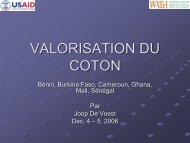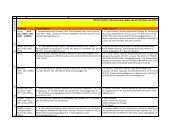A Brief Introduction to Textile Processing - AGOA Export Toolkit
A Brief Introduction to Textile Processing - AGOA Export Toolkit
A Brief Introduction to Textile Processing - AGOA Export Toolkit
You also want an ePaper? Increase the reach of your titles
YUMPU automatically turns print PDFs into web optimized ePapers that Google loves.
then removed using a solution of hot water and solvent, showing the pattern. Wax printing is simply<br />
an industrial application of the hand resist - dyeing method known as batik. Wax printing is still being<br />
done by some companies in West Africa, but more commonly the appearance of wax printing is now<br />
being printed <strong>to</strong> save the costly waxing process. With true wax printing, each length of fabric, though<br />
similar in pattern, is truly unique (as the wax cracks during the dyeing process, it imparts a unique<br />
pattern of its own). When this pattern is replicated without using the wax resist technique, the subtle<br />
uniqueness is lost, with each pattern repeat being identical.<br />
After<br />
dyeing and / or printing, fabrics are cured, or heated in a large oven <strong>to</strong> dry and set the dyes. For<br />
this process, fabrics are stretched on<strong>to</strong> a moving frame called a tenter frame. Fabric may either be<br />
clipped on<strong>to</strong> the frame at the edges of the fabric, or may be held in<strong>to</strong> place by placing the fabric over<br />
a line of short upright pins. Looking closely at the edge, or selvage of a fabric, you can sometimes see<br />
two rows of tiny holes. These are tenter frame pin marks. In rare cases they may cause problems in<br />
the fabric. If fabric is not straight (with warp and weft yarns perpendicular <strong>to</strong> each other) when<br />
placed on the tenter frame, it will become permanently skewed and garments made from the fabric<br />
will not hang properly, causing serious quality problems. A good example is the twisting of a pant leg.<br />
Screen<br />
printing. Though more commonly used for printing garments such as t – shirts, screen<br />
printing can also be used for fabrics. The method is basically the same whether used in an industrial<br />
or artisanal application. Patterns are transferred on<strong>to</strong> large, flat screens, with selected parts of the<br />
screen left porous and other parts blocked, according <strong>to</strong> the pattern and color. Each screen is placed<br />
over the flat fabric, and dye paste is forced through the porous areas of the screen, on<strong>to</strong> the fabric<br />
substrate. Like roller printing, each color in a pattern must be applied with one screen. Screens are<br />
placed sequentially over a fabric, <strong>to</strong> allow addition on each additional color. As in roller printing,<br />
great care must be taken <strong>to</strong> properly align the sequential screens over the fabric so all colors in the<br />
final pattern will be properly aligned as well.<br />
Thermal<br />
transfer (heat transfer) printing. Thermal transfer, or heat transfer as it is sometimes<br />
called, is the technologically simplest method of printing, but generally gives the poorest<br />
colorfastness. In this process, patterns are printed on<strong>to</strong> heat sensitive paper. The paper is placed<br />
against the fabric (or garments, as in the case of t – shirts), heat and pressure are applied, and the<br />
pattern transfers from the paper on<strong>to</strong> the fabric or garment. Heat transfer has been used extensively<br />
<strong>to</strong> print synthetic knits whose stretch makes it difficult <strong>to</strong> process on standard printing equipment.<br />
G arment dyeing<br />
While<br />
garments are generally made from dyed and / or printed fabrics or yarn, occasionally garments<br />
will be made from undyed / unprinted fabric, and dyed in garment form. More rarely, garments may<br />
be “overdyed” once assembled. In the former, color is applied <strong>to</strong> the garment only at the garment<br />
stage. In the latter case, the garment has been assembled from dyed yarn or dyed or printed fabric,<br />
but then is dyed again (with a weaker dye solution) at the garment stage <strong>to</strong> give a particular design<br />
look.<br />
Prepared by Margaret Bishop and Brent Smith for the West Africa Trade Hub 8/04 13









